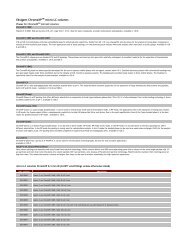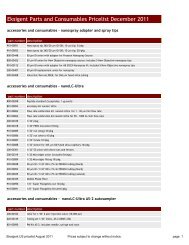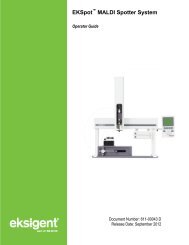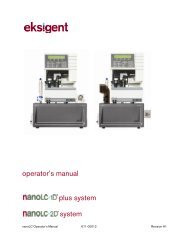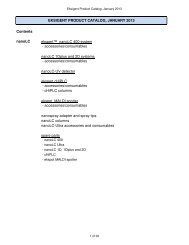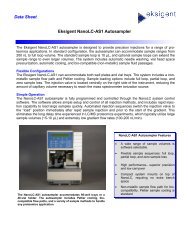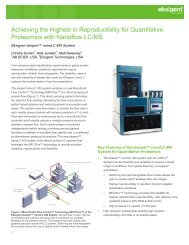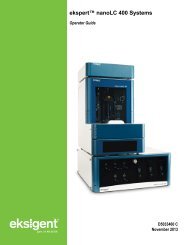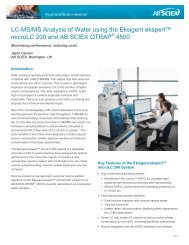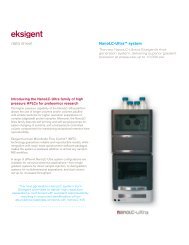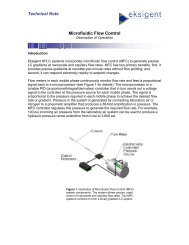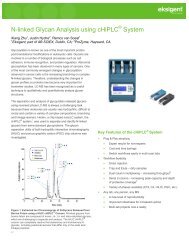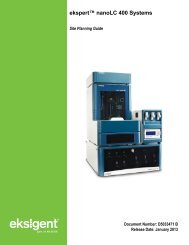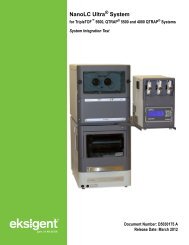cHiPLC-nanoflex system - Eksigent
cHiPLC-nanoflex system - Eksigent
cHiPLC-nanoflex system - Eksigent
- No tags were found...
You also want an ePaper? Increase the reach of your titles
YUMPU automatically turns print PDFs into web optimized ePapers that Google loves.
enefits of the <strong>cHiPLC</strong>-<strong>nanoflex</strong> <strong>system</strong>column designSpecial care has been given to the design of both thetrap-chips and analytical column-chips in order to achieveseparations that are equal or better than separationsobtained using packed capillaries (see Figure 1). The useof fused silica allows for cylindrical channels for packingnanoLC columns and traps. Instead of conventionalfrits made out of fused stationary phase particles, our<strong>cHiPLC</strong> columns use a unique weir structure to retain thestationary phase particles in the column. These weirs aremore reproducible to fabricate, while their dead-volume isvirtually zero (~13 pL). In addition, adsorption of samplecomponents that can occur with frit material is not an issuewith these types of structures.identical, and our packing procedure guarantees the bestpossible column-to-column reproducibility in nanoLC(see Figure 2). This is of importance for applications whereretention time stability over longer periods of time and overmultiple columns is important. Examples are the use ofretention time in combination with accurate mass in peptide/protein identification and scheduling MRMs for peptidequantitation in biomarker validation.Relative Abundance15 20 2530Time (min.)Figure 1. Comparison of the separation of a peptidetest mix on a nano <strong>cHiPLC</strong> column and a conventionalnanoLC column. Both columns are 15 cm x 75 µm, andpacked with ChromXP C18-CL 3 µm 300Å. Flowrate is250 nl/min; gradient slope 2% Acetonitrile/min.patented connection <strong>system</strong>Connections to and from each chip are made using apatented connection <strong>system</strong> that can connect up toseven channels to the outside world with a dead volumeof less than 1 nl. The force used to connect the chip ispre-set, so that every time the user exchanges a chip, aleak-free connection is obtained without any required useradjustments.increased column-to-column reproducibilityBesides the ease of replacing a nanoLC column or trap inseconds, the use of our <strong>cHiPLC</strong> columns also increasescolumn-to-column reproducibility. All chips are exactlyFigure 2. Excellent inter-column reproducibility is achievedfor a peptide test mix between three 15 cm x 75 µmnano <strong>cHiPLC</strong> columns packed with ChromXP C18-CL3 µm 300Å. Flowrate is 250 nl/min; gradient slope 2%Acetonitrile/min.simple operationThe <strong>cHiPLC</strong>-<strong>nanoflex</strong> allows for easy switching betweendirect injection, trap-loading and dual column with directinjection experiments. This is achieved through the use ofa fluidic jumper chip, which routes fluid appropriately for thedesired experiment. This jumper chip is as easily changedas the column and trap chips. Figure 3 shows a schematicof the set-up for a trap-loading experiment, showing thejumper, trap and column chip and the 10-port nano valve.nano-spray source compatibilityIn addition, the <strong>cHiPLC</strong>-<strong>nanoflex</strong> can be used in combinationwith all <strong>Eksigent</strong> nanoLC <strong>system</strong>s along with any massspectrometer/nanospray source.



